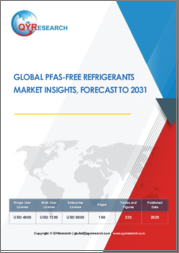
|
시장보고서
상품코드
1639216
천연 냉매 시장 기회, 성장 촉진요인, 산업 동향 분석, 예측(2025-2034년)Natural Refrigerants Market Opportunity, Growth Drivers, Industry Trend Analysis, and Forecast 2025 - 2034 |
||||||
천연 냉매 세계 시장은 2024년에 16억 달러로 평가되었고, 2025년부터 2034년에 걸쳐 CAGR 6.1%를 나타낼 것으로 예측됩니다.
이 성장을 가속하는 주요 요인은 친환경 냉매에 대한 수요 증가입니다. 환경에 미치는 영향을 줄이기 위해 지속가능한 솔루션을 선호하는 산업과 소비자가 늘어남에 따라 천연냉매가 인기를 끌고 있습니다. 이산화탄소, 암모니아, 탄화수소와 같은 이들 물질은 지구 온난화 계수(GWP)가 낮고 오존층 파괴 계수(ODP)가 0 또는 0에 가깝다는 것으로 알려져 있으며 HFC 및 CFC와 같은 합성 냉매의 대체품으로 선호됩니다. 천연 냉매로의 세계 이동은 고 GWP 냉매의 단계적 폐지를 촉진하는 정부 규제와 국제 협정에 의해 더욱 강화되고 있습니다.
식품가공, 냉장창고, 소매 등의 부문은 지속가능성 목표를 달성하고 이산화탄소 배출량을 줄이고 진화하는 규제를 준수하기 위해 천연냉매의 채택을 주도하고 있습니다. 이러한 냉매의 환경면에서의 이점에 대한 인식이 높아짐에 따라 에너지 효율적인 냉각 시스템에 대한 수요가 확대될 것으로 예상됩니다. 이러한 추세로 인해 천연 냉매는 다양한 산업과 지역에서 선호되는 옵션으로 자리매김하고 있습니다.
시장은 다양한 유형으로 나뉘며 암모니아가 선도하고 2024년에는 7억 670만 달러의 수익을 창출했습니다. 암모니아는 높은 에너지 효율과 환경에 미치는 영향이 적기 때문에 최고의 선택입니다. 지구 온난화 계수가 낮은 비 오존층 파괴 물질로서 암모니아는 산업용 냉동에 널리 사용됩니다. 그러나 독성과 인화성이 있으므로 취급에 주의가 필요합니다.
| 시장 범위 | |
|---|---|
| 시작연도 | 2024 |
| 예측연도 | 2025-2034 |
| 시작금액 | 16억 달러 |
| 예측 금액 | 29억 달러 |
| CAGR | 6.1% |
용도별로는 지속 가능한 냉매의 채용에 의해 냉장 창고가 최대 시장 점유율을 차지하고 있습니다. 이러한 천연냉매는 규제기준을 충족할 뿐만 아니라 에너지 효율도 높기 때문에 장기적으로 운영비용을 절감할 수 있습니다. 최신 기술에 대한 초기 투자에도 불구하고 냉장 창고 시설은 지속가능성 향상과 녹색 기준 준수를 통해 이익을 얻고 있습니다.
최종 사용자별로 산업 부문은 시장의 50% 이상을 차지합니다. 천연냉매는 에너지 효율이 높고 환경부하가 낮기 때문에 식품가공, 의약품, 화학 등의 산업에서 높은 지지를 받고 있습니다. 환경 규제에 대한 대응에 대한 압력 증가가 이러한 전환을 가속화하고 있습니다.
미국의 천연 냉매 시장은 2024년 2억 5,500만 달러로 평가되었으며, 규제 요건과 보다 친환경 솔루션으로의 전환으로 빠르게 성장하고 있습니다. 산업계가 이러한 지속가능한 대안을 채택함에 따라 북미 시장은 정부의 지원과 친환경 제품에 대한 소비자 수요 증가 모두에서 혜택을 누리고 있습니다.
목차
제1장 조사 방법과 조사 범위
제2장 주요 요약
제3장 업계 인사이트
- 생태계 분석
- 밸류체인에 영향을 주는 요인
- 이익률 분석
- 파괴
- 장래의 전망
- 제조업체
- 유통업체
- 공급자의 상황
- 이익률 분석
- 주요 뉴스와 대처
- 규제 상황
- 영향요인
- 성장 촉진요인
- 친환경 냉매에 대한 수요 증가
- 산업용도에서의 채용 확대
- 냉매 기술의 진보
- 업계의 잠재적 위험 및 과제
- 높은 초기 도입 비용
- 합성 냉매와의 경쟁
- 성장 촉진요인
- 성장 가능성 분석
- Porter's Five Forces 분석
- PESTEL 분석
제4장 경쟁 구도
- 소개
- 기업 점유율 분석
- 경쟁 포지셔닝 매트릭스
- 전략 전망 매트릭스
제5장 시장 규모와 예측 : 유형별, 2021년-2034년
- 주요 동향
- 암모니아
- 이산화탄소
- 탄화수소
- 기타(클로로플루오로카본, 하이드로클로로플루오로카본)
제6장 시장 규모와 예측 : 용도별, 2021년-2034년
- 주요 동향
- 냉장 창고
- 냉동고
- 식품가공
- 에어컨
- 기타(히트펌프, 데이터센터)
제7장 시장 규모와 예측 : 최종 용도별, 2021년-2034년
- 주요 동향
- 산업
- 상업
- 주택
제8장 시장 규모와 예측 : 지역별, 2021년-2034년
- 주요 동향
- 북미
- 미국
- 캐나다
- 유럽
- 영국
- 독일
- 프랑스
- 이탈리아
- 스페인
- 러시아
- 아시아태평양
- 중국
- 인도
- 일본
- 한국
- 호주
- 라틴아메리카
- 브라질
- 멕시코
- 중동 및 아프리카
- 남아프리카
- 사우디아라비아
- 아랍에미리트(UAE)
제9장 기업 프로파일
- A-Gas International
- AGC
- Air Liquide
- Danfoss
- engas Australasia
- HyChill Australia
- Linde plc
- Puyang Zhongwei Fine Chemical
- Shandong Yuean Chemical Industry
- Tazzetti SpA
The Global Natural Refrigerants Market is valued at USD 1.6 billion in 2024 and is expected to grow at a CAGR of 6.1% from 2025 to 2034. A key factor driving this growth is the increasing demand for eco-friendly refrigerants. As more industries and consumers prioritize sustainable solutions to reduce their environmental impact, natural refrigerants are gaining traction. These substances, such as carbon dioxide, ammonia, and hydrocarbons, are known for their low Global Warming Potential (GWP) and zero or near-zero Ozone Depletion Potential (ODP), making them a preferred alternative to synthetic refrigerants like HFCs and CFCs. The global shift toward natural refrigerants is further reinforced by government regulations and international agreements, which promote the phaseout of high-GWP refrigerants.
Sectors such as food processing, cold storage, and retail are leading the charge in adopting natural refrigerants to meet sustainability targets, lower carbon footprints, and comply with evolving regulations. With increasing awareness about the environmental benefits of these refrigerants, the demand for energy-efficient cooling systems is expected to grow. This trend positions natural refrigerants as a preferred choice across various industries and regions.
The market is divided into different types, with ammonia leading the way, generating USD 706.7 million in 2024. Ammonia is a top choice due to its high energy efficiency and minimal environmental impact. As a non-ozone-depleting substance with a low global warming potential, ammonia is widely used in industrial refrigeration. However, it requires careful handling due to its toxicity and flammability.
| Market Scope | |
|---|---|
| Start Year | 2024 |
| Forecast Year | 2025-2034 |
| Start Value | $1.6 Billion |
| Forecast Value | $2.9 Billion |
| CAGR | 6.1% |
When it comes to applications, cold storage accounts for the largest market share, driven by its adoption of sustainable refrigerants. These natural refrigerants not only meet regulatory standards but also offer better energy efficiency, which reduces operational costs in the long run. Despite the initial investment in updated technologies, cold storage facilities benefit from enhanced sustainability and compliance with green standards.
In terms of end users, the industrial sector dominates the market, accounting for over 50% of the share. Natural refrigerants are highly favored in industries such as food processing, pharmaceuticals, and chemicals because of their energy efficiency and low environmental impact. The increasing pressure to comply with environmental regulations is accelerating this transition.
The U.S. natural refrigerants market, valued at USD 255 million in 2024, is experiencing rapid growth driven by regulatory requirements and a shift toward greener solutions. As industries adopt these sustainable alternatives, the market in North America is benefiting from both government support and growing consumer demand for eco-friendly products.
Table of Contents
Chapter 1 Methodology & Scope
- 1.1 Market scope & definition
- 1.2 Base estimates & calculations
- 1.3 Forecast calculation
- 1.4 Data sources
- 1.4.1 Primary
- 1.4.2 Secondary
- 1.4.2.1 Paid sources
- 1.4.2.2 Public sources
Chapter 2 Executive Summary
- 2.1 Industry synopsis, 2021-2034
Chapter 3 Industry Insights
- 3.1 Industry ecosystem analysis
- 3.1.1 Factor affecting the value chain
- 3.1.2 Profit margin analysis
- 3.1.3 Disruptions
- 3.1.4 Future outlook
- 3.1.5 Manufacturers
- 3.1.6 Distributors
- 3.2 Supplier landscape
- 3.3 Profit margin analysis
- 3.4 Key news & initiatives
- 3.5 Regulatory landscape
- 3.6 Impact forces
- 3.6.1 Growth drivers
- 3.6.1.1 Rising demand for eco-friendly refrigerants
- 3.6.1.2 Growing adoption in industrial applications
- 3.6.1.3 Advancements in refrigerant technologies
- 3.6.2 Industry pitfalls & challenges
- 3.6.2.1 High initial installation costs
- 3.6.2.2 Competition from synthetic refrigerants
- 3.6.1 Growth drivers
- 3.7 Growth potential analysis
- 3.8 Porter's analysis
- 3.9 PESTEL analysis
Chapter 4 Competitive Landscape, 2024
- 4.1 Introduction
- 4.2 Company market share analysis
- 4.3 Competitive positioning matrix
- 4.4 Strategic outlook matrix
Chapter 5 Market Size and Forecast, By Type, 2021-2034 (USD Billion) (Kilo Tons)
- 5.1 Key trends
- 5.2 Ammonia
- 5.3 Carbon dioxide
- 5.4 Hydrocarbon
- 5.5 Others (chlorofluorocarbon and hydrochlorofluorocarbon)
Chapter 6 Market Size and Forecast, By Application, 2021-2034 (USD Billion) (Kilo Tons)
- 6.1 Key trends
- 6.2 Cold storage
- 6.3 Freezers
- 6.4 Food processing
- 6.5 Air conditioners
- 6.6 Others (heat pumps, data centers)
Chapter 7 Market Size and Forecast, By End Use, 2021-2034 (USD Billion) (Kilo Tons)
- 7.1 Key trends
- 7.2 Industrial
- 7.3 Commercial
- 7.4 Residential
Chapter 8 Market Size and Forecast, By Region, 2021-2034 (USD Billion) (Kilo Tons)
- 8.1 Key trends
- 8.2 North America
- 8.2.1 U.S.
- 8.2.2 Canada
- 8.3 Europe
- 8.3.1 UK
- 8.3.2 Germany
- 8.3.3 France
- 8.3.4 Italy
- 8.3.5 Spain
- 8.3.6 Russia
- 8.4 Asia Pacific
- 8.4.1 China
- 8.4.2 India
- 8.4.3 Japan
- 8.4.4 South Korea
- 8.4.5 Australia
- 8.5 Latin America
- 8.5.1 Brazil
- 8.5.2 Mexico
- 8.6 MEA
- 8.6.1 South Africa
- 8.6.2 Saudi Arabia
- 8.6.3 UAE
Chapter 9 Company Profiles
- 9.1 A-Gas International
- 9.2 AGC
- 9.3 Air Liquide
- 9.4 Danfoss
- 9.5 engas Australasia
- 9.6 HyChill Australia
- 9.7 Linde plc
- 9.8 Puyang Zhongwei Fine Chemical
- 9.9 Shandong Yuean Chemical Industry
- 9.10 Tazzetti S.p.A.

















